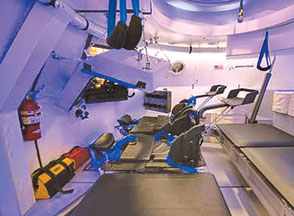|
Tablet-controlled with ambient lighting:
Inside Boeing's next-gen spaceship
New CST-100 will shuttle NASA astronauts up to the ISS
 Looking more like a futuristic hotel than a spaceship destined for
the International Space Station (ISS), Boeing have unveiled the interior
stylings of their next-gen shuttle: the CST-100. Looking more like a futuristic hotel than a spaceship destined for
the International Space Station (ISS), Boeing have unveiled the interior
stylings of their next-gen shuttle: the CST-100.
The expected banks of switches and flashing lights have been replaced
with “ambient sky-blue LED lighting” and smoothly curving walls, whilst
the bulky straps of the old seats have been removed in favour of leather
contraptions that look like they could double up as gym equipment.
Destined to replace the NASA Space Shuttle that was retired in 2011,
the CST-100 (it stands for Crew Space Transportation) will transport up
to seven astronauts up to the ISS, and it's simplified interior reflects
this mission:
“What you're not going to find is 1,100 or 1,600 switches,” said
Chris Ferguson, director of Boeing's Crew and Mission Operations and a
former NASA astronaut.
“When these guys go up in this, they're primary mission is not to fly
this spacecraft, they're primary mission is to go to the space station
for six months.
So we don't want to burden them with an inordinate amount of training
to fly this vehicle. We want it to be intuitive.”
Boeing are even going to be using tablets to replace the
old-fashioned controls, though there's been no words as to whether the
company will be going for an iPad or an Android device.
The exterior of the capsule is one point of familiarity and with good
reason: Boeing were also partly responsible for the iconic Apollo-era
capsules of the 60s and early 70s.
However, new manufacturing techniques have greatly expanded the
interior space and craft durability, and the CST-100 will be constructed
without any welding at all: a new process called ‘spin forming’
fabricates the body of the spacecraft in a method reminiscent of a
potter shaping a pot.
- The Independent |


